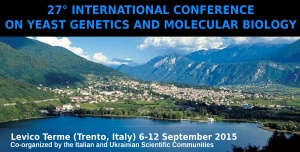SGD Quarterly Newsletter, Summer 2015
About this newsletter:
This is the Summer 2015 issue of the quarterly SGD newsletter. The goal of this newsletter is to inform our users about new features in SGD and to foster communication within the yeast community.
You can also subscribe to SGD's RSS feed to receive updates on SGD news:
http://www.yeastgenome.org/feed
Contents
- 1 SGD at the 27th International Conference on Yeast Genetics and Molecular Biology (ICYGMB)
- 2 Upcoming meeting: Cell Biology of Yeast Meeting at Cold Spring Harbor Labs
- 3 Yeast-Human Functional Complementation Data Now in SGD
- 4 SGD’s 60-second Help Videos
- 5 Research Spotlight (Blog posts)
- 6 What else did we do over the summer?
- 7 Recent Publications by SGD staff
SGD at the 27th International Conference on Yeast Genetics and Molecular Biology (ICYGMB)
SGD staff will be hosting a workshop, posters, and an exhibit table at the 27th International Conference on Yeast Genetics and Molecular Biology (ICYGMB) to be held in Levico Terme, Trento, Italy, from 6th to 12th September 2015.
SGD will showcase the items mentioned below and more! At the Getting More Out of SGD workshop, we will be discussing our curation efforts in capturing yeast-human functional complementation data, the new sequence Variant Viewer, new data in YeastMine and more. Bring your questions and comments - we love feedback!
Workshop: Getting More out of SGD
Date: Sunday, September 6th, 4PM
Featured Topics: Yeast-human functional complementation data, the new Variant Viewer, new data in YeastMine
Find these SGD staff members, as well as those presenting posters, at the Workshop and the Exhibit table:
Exhibit Table
SGD will also have an exhibit table at the ICYGMB. Come by to take a spin on our site, learn about various features of the database, and provide us with feedback regarding how we can improve SGD and receive a prize! Look for us wearing our SuperBud fleece jackets, and feel free to flag any of us down!
Posters
In addition to the Workshop, SGD staff will present three posters - please stop by and chat with us!
| Poster Title | Presenter |
| Integrating genome-wide datasets into the Saccharomyces Genome Database | |
| Inferring Genome Variation Patterns in Saccharomyces cerevisiae using the Eukaryote Pan-Genome Toolset | |
| Homology curation at SGD: budding yeast as a model for eukaryotic biology |
Upcoming meeting: Cell Biology of Yeast Meeting at Cold Spring Harbor Labs
SGD staff will be at the Cell Biology of Yeast Meeting to showcase whats new at SGD. Come find us at the exhihit table!
Yeast-Human Functional Complementation Data Now in SGD
Yeast and humans diverged about a billion years ago. So if there’s still enough functional conservation between a pair of similar yeast and human genes that they can be substituted for each other, we know they must be critically important for life. An added bonus is that if a human protein works in yeast, all of the awesome power of yeast genetics and molecular biology can be used to study it.
To make it easier for researchers to identify these “swappable” yeast and human genes, we’ve started collecting functional complementation data in SGD. The data are all curated from the published literature, via two sources. One set of papers was curated at SGD, including the recent systematic study of functional complementation by Kachroo and colleagues. Another set was curated by Princeton Protein Orthology Database (P-POD) staff and is incorporated into SGD with their generous permission.
As a starting point, we’ve collected a relatively simple set of data: the yeast and human genes involved in a functional complementation relationship, with their respective identifiers; the direction of complementation (human gene complements yeast mutation, or vice versa); the source of curation (SGD or P-POD); the PubMed ID of the reference; and an optional free-text note adding more details. In the future we’ll incorporate more information, such as the disease involvement of the human protein and the sequence differences found in disease-associated alleles that fail to complement the yeast mutation.
You can access these data in two ways: using two new templates in YeastMine our data warehouse; or via our Download page. Please take a look, let us know what you think, and point us to any published data that’s missing. We always appreciate your feedback!
Accessing Functional Complementation Data
YeastMine is a versatile tool that lets you customize searches and create and manipulate lists of search results. To help you get started with YeastMine we've created a series of short video tutorials explaining its features.
Gene --> Functional Complementation template
This template lets you query with a yeast gene or list of genes (either your own custom list, or a pre-made gene list) and retrieve the human gene(s) involved in cross-species complementation along with all of the data listed above.
Human Gene --> Functional Complementation template
This template takes either human gene names (HGNC -approved symbols) or Entrez Gene IDs for human genes and returns the yeast gene(s) involved in cross-species complementation, along with the data listed above. You can run the query using a single human gene as input, or create a custom list of human genes in YeastMine for the query. We've created two new pre-made lists of human genes that can also be used with this template. The list "Human genes complementing or complemented by yeast genes" includes only human genes that are currently included in the functional complementation data, while the list "Human genes with yeast homologs" includes all human genes that have a yeast homolog as predicted by any of several methods.
Downloading Functional Complementation Data
If you'd prefer to have all the data in one file, simply visit our Curated Data download page and download the file "functional_complementation.tab".
SGD’s 60-second Help Videos
SGD is actively expanding its library of short video tutorials designed to help you use various SGD tools and pages. Check out the latest new videos available for the following topics:
- Interactions Overview and Network
- Genome Snapshot
- Yeast-Human Functional Complementation Data
- Reserving a Gene Name
- Working with Lists in YeastMine
All videos are accessible via the SGD Video Tutorials page and through SGD’s YouTube channel.
Research Spotlight (Blog posts)
In case you missed them, these were some of the most popular Research Spotlight posts on our home page recently:
Ancient Hybridization Causes Revision of Yeast's Calendar. The whole-genome duplication of Saccharomyces cerevisiae has been taken as gospel. But new work from Marcet-Houben and Gabaldón suggests that budding yeast's history is more complicated than we thought.
Private Nurses Help Birth Ribosomal Proteins. Pausch and colleagues show that some ribosomal proteins are such potential troublemakers that they need individual chaperones to keep them swaddled and safe until they settle into the mature ribosome.
Where's That Protein?. We can now pinpoint the locations of more than 4,000 yeast proteins, thanks to nine BILLION measurements made at the University of Toronto, published by Chong et al. and Koh et al..
Yeast are People Too. A new study by Kachroo et al. in the Marcotte lab shows that when you look under the hood, yeast and human cells not only look similar but even have hundreds of interchangeable parts.
What else did we do over the summer?
- Robert Nash, a senior biocuration scientist at SGD, presented a tutorial at the YEAST GENETICS & GENOMICS course at CSHL, on what data is available at SGD, how to use YeastMine. Slides from his presentation are available at SGD.
- Travis Sheppard, a software engineer at SGD, attended the React.js Europe conference at Paris to learn more about techniques, best practices, and emerging technologies related to the use of React.js in web development and user interfaces. He also attended the Eyeo Festival in Minneapolis to an insight into the processes used by designers for data visualization.
Recent Publications by SGD staff
- Skrzypek MS, Nash RS (2015) Biocuration at the Saccharomyces Genome Database. Genesis. 2015 Aug;53(8):450-7. doi: 10.1002/dvg.22862. Epub 2015 Jul 3. PMID: 25997651
- Song G, Dickins BJ, Demeter J, Engel S, Dunn B, Cherry JM (2015) AGAPE (Automated Genome Analysis PipelinE) for Pan-Genome Analysis of Saccharomyces cerevisiae. PLoS One. 2015 Mar 17;10(3):e0120671. doi: 10.1371/journal.pone.0120671. eCollection 2015. PMID: 25781462





